The daily reports about how agriculture is killing us are certainly alarming. However, when I carefully examine each report, the sensational headlines never seem to match reality. The claims originate usually from either unpublished reports, or re-interpretations of legitimately-published work where the conclusions have little to no relationship to the scandalous headline.
Today’s example came to me via Twitter when I read the post below. Pesticides associated with amyotrophic lateral sclerosis (ALS; Lou Gehrig’s Disease) progression? Okay, I’ll take a look at the data and see what they authors found. The referenced study is here.
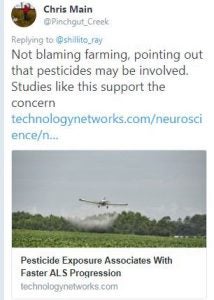
An analysis of 167 cases of ALS examined patients’ blood levels of select compounds. The authors found associations between levels of specific organic compounds and the progression of disease.
But they were not pesticides. At least anything used in a long, long time.
The big offenders were polycholorinated biphenyls (PCBs) and polybrominated diphenyl esters (PBCEs), known toxic compounds from paper/plastics/electronics manufacturing and a class of flame retardants. No pesticides.
In fact, the study did not even test modern-day pesticides. They examined the levels of components of chlordane (cis- and trans-nonachlor, and chlordane itself) a compound that has been banned since the 1980s. It is a reasonable idea to test for it, as it is environmentally persistent, and its components are health hazards.
They also examined levels of hexachlorocyclohexene (HCH) and Dichlorodiphenyldichloroethylene (p.p’ DDE; the breakdown product of DDT). This makes sense too, as these long-banned compounds are persistent chemistries that still can be detected in those exposed, years after exposure.
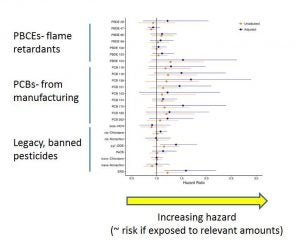
The figure above is a modification of Figure 1 of Goutman et al. (2019). I added the classifications and description of the trend. The more potentially hazardous the compounds are, the more to the right the dot will be placed, and the x axis defines the strength of the association. For the pesticides examined, only DDT (as determined by its breakdown product p.p’ DDE) associated with increased risk, showing a 1.39 times higher mortality rate (95 percent CI 1.07 to 1.81). Good thing that has been outlawed for 50 years.
So where did the post on Twitter get the idea that this was pesticide driven? A click on the link takes you to this article:
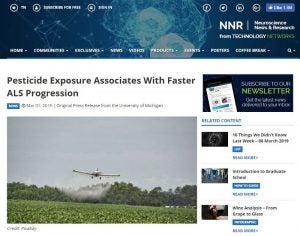
Neuroscience News and Research posts articles with a nice crop dusting picture, when the data do not support the headline. So where is this bad information coming from?
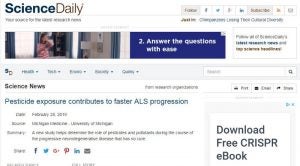
Science Daily, with “science” right in the name, repeats this false information. Does anyone actually read a story before they post it? How about Medical News Today … do they get it right? Here’s a photo and a caption from the article.
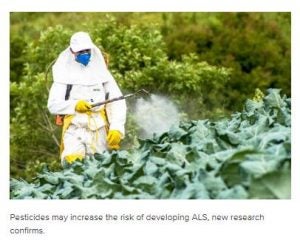
No, what is stated in the caption is actually the opposite of what Goutman et al. (2019) reported. Do these reporters even read the articles they report on? Where could misinformation like this possibly originate? Look no further than the university itself!
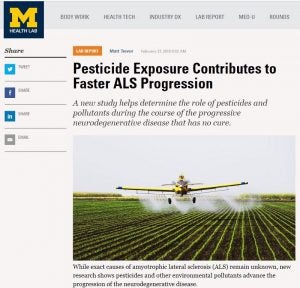
After reading the paper it is clear that the conclusions do not match the title of the article, the photo, or the subhead.
The article by University of Michigan Neurobiology Communications Director Matt Trevor does speak accurately to the findings of the study and then notes that Michigan is filled with 69 Superfund sites and that DDT was used in the middle of last century. That all makes perfect sense and is a good rationale to do the study and report the findings.
But then why say that “Pesticide Exposure Contributes to Faster ALS Progression” and show a picture of a modern-day aircraft spraying a field of crops?
The answer? Because trashing agriculture and scaring people about their food gets clicks.
This is classic sensationalism to get traffic, possibly lazy reporting. However, the body of the piece was reasonable, just the headline, subhead, and photo (the stuff that most people read) are completely wrong.
Science Daily and Neuroscience News and Research then perpetuate the misinformation through trusted, scientifically vetted channels, installing a new bit of false information into the growing arsenal of those who criticize the safety of farming.
And don’t think that a bogus interpretation will just go away unnoticed.
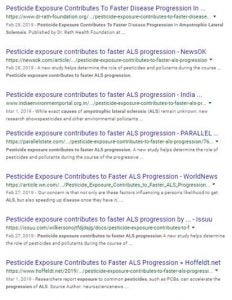
It reminds us again that scientists and farmers have a new role as watchdogs of the popular press and of university communications offices. Oversteps and sexy headlines can be dangerous, as they misrepresent scientists’ work, as well as further erode trust in safe food and farming.
Kevin Folta is a land-grant scientist exploring ways to make better food with less input, and how to communicate science. This article was published with his permission. All of Dr. Folta’s funding can be found at kevinfolta.com/transparency.



